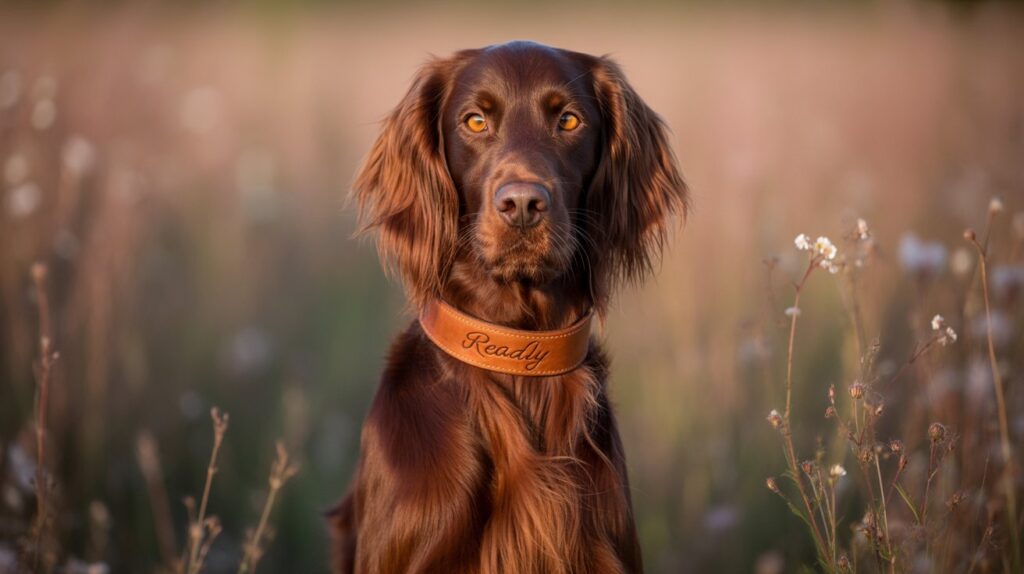Table of Contents
- Introduction to the Irish Setter
- A Noble History: Origins of the Irish Setter
- Defining Features: Appearance and Breed Standard
- Coat and Colour
- Size and Stature
- The Heart of the Breed: Temperament and Personality
- Energy and Intellect: Training and Exercise Requirements
- Exercise Needs
- Training and Socialisation
- Grooming and General Care
- Health and Lifespan: What to Expect
- Is the Irish Setter the Right Dog for Your Family?
- Conclusion: The Enduring Allure of the Red Setter
- Frequently Asked Questions (FAQs)
An Introduction to the Irish Setter
The Irish Setter, with its rich, mahogany coat and elegant, athletic build, is one of the most recognisable and admired dog breeds in the world. Often called the “Red Setter,” this breed is more than just a pretty face. Originally developed in Ireland as a tireless and efficient gundog, the Irish Setter possesses a unique blend of high spirits, intelligence, and an overwhelmingly friendly nature. This article explores the multifaceted world of this stunning breed, from its historical roots on the hunting fields of Ireland to its modern-day status as a cherished family companion.

A Noble History: Origins of the Irish Setter
The story of the Irish Setter begins in 18th-century Ireland. The breed was meticulously developed from a mix of other hunting dogs, including the Irish Water Spaniel, English Setter, Pointer, and Gordon Setter. The initial goal was to create the perfect gundog for “setting”—a hunting technique where the dog locates game birds and then freezes or “sets,” indicating the location to the hunter.
Early versions of the breed, known as Red and White Setters, were highly prized for their stamina and keen sense of smell. Over time, selective breeding favoured the solid red coat, and by the 19th century, the magnificent all-red Irish Setter we know today had emerged as a distinct and popular breed. While still an exceptional field dog, its striking appearance and affable personality quickly earned it a place in the show ring and, more importantly, in the homes of families worldwide.
Defining Features: Appearance and Breed Standard
The Irish Setter’s appearance is one of grace and power. They are athletic dogs built for speed and endurance, carrying themselves with a dignified yet alert expression.
Coat and Colour
The breed’s most defining characteristic is its coat. The colour is a stunning, rich shade of mahogany or deep chestnut red, free of any black. The hair is long and silky, particularly on the ears, chest, tail, and the back of the legs, where it forms elegant feathering. This beautiful coat serves a practical purpose, offering protection from rough terrain and cold weather.
Size and Stature
Irish Setters are substantial, medium-to-large-sized dogs.
- Males typically stand between 26 to 28 inches (66textto71textcm) at the shoulder and weigh around 70 pounds (32textkg).
- Females are slightly smaller, standing 24 to 26 inches (61textto66textcm) tall and weighing about 60 pounds (27textkg).
Their build is lean but muscular, with a deep chest and a long, graceful neck, all contributing to their aristocratic and athletic silhouette.
The Heart of the Breed: Temperament and Personality
The Irish Setter is renowned for its outgoing, friendly, and deeply affectionate temperament. They are exuberant and playful, often retaining a puppy-like enthusiasm well into adulthood. This is not a shy or reserved breed; an Irish Setter loves to be at the centre of family activities and thrives on human companionship.
Key personality traits include:
- Affectionate: They form strong bonds with their families and can be quite demonstrative with their love.
- High-Spirited: Full of energy and life, they approach everything with enthusiasm.
- Intelligent: They are smart dogs, but this intelligence is often paired with a mischievous and independent streak, which can present training challenges.
- Sociable: Generally, they get along well with children, other dogs, and even strangers, whom they greet with a wagging tail.
Energy and Intellect: Training and Exercise Requirements
Understanding the Irish Setter’s background as a working gundog is crucial to meeting its needs for physical and mental stimulation.
Exercise Needs
This is a high-energy breed that requires significant daily exercise to stay happy and healthy. A short walk on a leash is not enough. An adult Irish Setter needs at least 60-90 minutes of vigorous activity each day. This can include:
- Running in a securely fenced area
- Long hikes or jogging
- Canine sports like agility, flyball, or field trials
- Games of fetch
Without adequate exercise, they can become bored and frustrated, which may lead to destructive behaviour like chewing or digging.
Training and Socialisation
Early socialisation and consistent, patient training are essential for the Irish Setter. Their intelligence means they learn quickly, but their independent nature and boundless energy can make them easily distracted.
- Positive Reinforcement: They respond best to training methods that use praise, treats, and play as rewards. Harsh corrections can damage their sensitive spirit.
- Consistency is Key: Sessions should be kept short, fun, and engaging to hold their attention.
- Recall: Due to their hunting instincts, teaching a reliable recall command from a young age is paramount, especially if you plan to let them off-leash in safe areas.
Grooming and General Care
The Irish Setter’s beautiful coat requires regular maintenance to prevent mats and tangles and to keep it looking its best.
- Brushing: Plan to brush your Setter at least two to three times a week with a pin brush and a comb to work through the feathering.
- Bathing: Baths are only needed occasionally, or when the dog gets particularly dirty.
- Nail Trimming: Regular nail trims are important to prevent discomfort and foot problems.
- Ear Checks: Their long, floppy ears can trap moisture and debris, making them prone to infections. Check and clean their ears weekly.
Health and Lifespan: What to Expect
The Irish Setter is generally a healthy breed with an average lifespan of 12 to 15 years. However, like all purebred dogs, they are susceptible to certain genetic health conditions. Responsible breeders will screen their breeding stock for these issues. Common concerns include:
- Hip Dysplasia: A malformation of the hip joint.
- Progressive Retinal Atrophy (PRA): A degenerative eye disease that can lead to blindness.
- Bloat (Gastric Dilatation-Volvulus): A life-threatening stomach condition common in deep-chested breeds.
- Hypothyroidism: An underactive thyroid gland.
- Canine Leukocyte Adhesion Deficiency (CLAD): A genetic immune system disorder.
Regular veterinary check-ups and a healthy lifestyle can help ensure a long and happy life for your Irish Setter.
Is the Irish Setter the Right Dog for Your Family?
The Irish Setter can make a phenomenal family pet, but they are not the right fit for every household. They thrive in active homes where they have plenty of space to run and are included in family life. They are wonderful with children, often acting as patient and playful companions.
However, their high energy levels and need for companionship mean they do not do well when left alone for long periods. Potential owners should be prepared to commit significant time to exercise, training, and grooming. If you lead an active lifestyle and are looking for a loyal, joyful, and stunningly beautiful canine friend, the Irish Setter might be the perfect choice.
Conclusion: The Enduring Allure of the Red Setter
From the rugged fields of Ireland to the comfort of the family sofa, the Irish Setter has captivated hearts for centuries. This breed is a remarkable combination of elegance, athleticism, and unwavering devotion. While their grooming and exercise needs are demanding, the reward is a lifetime of companionship from a dog whose joyful spirit and loving nature are truly second to none. The Irish Setter is more than just a dog; it is a vibrant, affectionate member of the family.
Frequently Asked Questions (FAQs)
Q1: Are Irish Setters good with children? A1: Yes, Irish Setters are generally excellent with children. They are patient, playful, and good-natured. As with any breed, supervision is recommended, especially with very young children, due to the Setter’s boisterous energy.
Q2: Do Irish Setters shed a lot? A2: Irish Setters are considered moderate shedders. Regular brushing (2-3 times per week) is necessary to manage shedding and prevent their long, silky hair from matting.
Q3: Can Irish Setters live in apartments? A3: While it is possible, it is not ideal. Their high energy levels and need for space make them better suited to homes with a securely fenced yard. If living in an apartment, owners must be extremely dedicated to providing ample daily exercise outdoors.
Q4: Are Irish Setters easy to train? A4: They are intelligent and capable of learning quickly, but they also have an independent and sometimes mischievous streak. They require patient, consistent training using positive reinforcement methods. Their attention can wander, so keeping training sessions fun and engaging is crucial.
Q5: What is the main difference between an Irish Setter and a Red Setter? A5: There is no difference. “Red Setter” is simply a common nickname for the Irish Setter, referring to its distinct, solid red coat.
